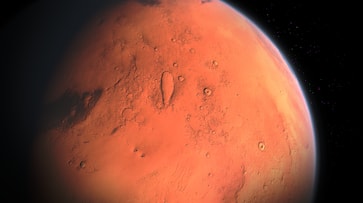"I touched down on #Mars six years ago. Celebrating my 6th landing anniversary with the traditional gift of iron oxide. (It puts the red in Red Planet.)," the rover's social media handle tweeted
NASA's Curiosity rover - a mission that has spotted evidence of liquid water as well as potential signs life and habitability on Mars - has completed six years on the red planet.
"I touched down on #Mars six years ago. Celebrating my 6th landing anniversary with the traditional gift of iron oxide. (It puts the red in Red Planet.)," the rover's social media handle tweeted.
The Mars Science Laboratory mission's Curiosity rover landed on the red planet's Gale Crater on August 6 using a series of complicated landing manoeuvres never before attempted.
Curiosity's mission is to determine whether the red planet ever was, or is, habitable to microbial life.
The rover, which is about the size of a car, is equipped with 17 cameras and a robotic arm containing a suite of specialised laboratory-like tools and instruments.
The specialised landing sequence, which employed a giant parachute, a jet-controlled descent vehicle and a bungee-like apparatus called a "sky crane," was devised because tested landing techniques used during previous rover missions could not safely accommodate the much larger and heavier rover.
The Curiosity rover is currently experiencing a global storm that has been raging in Mars for weeks.
In 2013, the Curiosity rover found that ancient Mars had the right chemistry to support living microbes.
The rover discovered evidence of sulphur, nitrogen, oxygen, phosphorus and carbon - key ingredients necessary for life - in the powder sample drilled from the "Sheepbed" mudstone in Yellowknife Bay.
The sample collected by the rover also revealed clay minerals and not too much salt, which suggests fresh, possibly drinkable water once flowed there.
Shortly after, smooth and rounded rocks were found by Curiosity, indicating that a steady knee-deep stream of water once flowed on the red planet.
In 2014, the rover detected a background level of atmospheric methane and observed a ten-fold increase in methane over a two-month period.
The finding generated a lot of interest as methane can be produced by living organisms or by chemical reactions between rock and water, for example.
In 2015, organic molecules - the building blocks of life - were discovered on Mars after a long search by the Sample Analysis at Mars (SAM) instrument in a powdered rock sample from the "Sheepbed" mudstone in "Yellowknife Bay."
The finding shows that raw ingredients existed for life to get started there at one time.
Last Updated Aug 6, 2018, 2:33 PM IST






![Salman Khan sets stage on fire for Anant Ambani, Radhika Merchant pre-wedding festivities [WATCH] ATG](https://static-gi.asianetnews.com/images/01hr1hh8y86gvb4kbqgnyhc0w0/whatsapp-image-2024-03-03-at-12-24-37-pm_100x60xt.jpg)
![Pregnant Deepika Padukone dances with Ranveer Singh at Anant Ambani, Radhika Merchant pre-wedding bash [WATCH] ATG](https://static-gi.asianetnews.com/images/01hr1ffyd3nzqzgm6ba0k87vr8/whatsapp-image-2024-03-03-at-11-45-35-am_100x60xt.jpg)


